Chris Eboch's Blog, page 5
November 24, 2021
Are you #amwriting or #amediting? Give yourself or the writers in your life a #blackfriday gift to follow up #NaNoWriMo - #writing books for #KidLit and other plotters
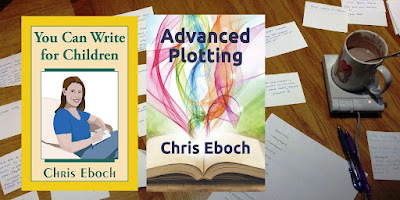 Take your novel to the next level.
Take your novel to the next level. You’ve finished a few manuscripts, read books and articles on writing, taken some classes, attended conferences. But you still struggle with plot, or suspect that your plotting needs work.
This book can help.
“Advanced Plotting is helping me to be more focused, to stop and ask the right questions, to dig deeper.”
Advanced Plotting is designed for the intermediate and advanced writer. Read the book straight through, study the index to find help with your current problem, or dip in and out randomly — however you use this book, you’ll find fascinating insights and detailed tips to help you build a stronger plot and become a better writer.
“This really is helping me a lot. It's written beautifully and to-the-point. The essays really help you zero in on your own problems in your manuscript. The Plot Outline Exercise is a great tool!”
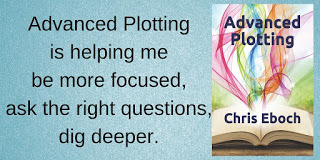 The Plot Outline Exercise is designed to help you work with a completed manuscript to identify and fix plot weaknesses. It can also help flesh out an outline. Additional articles address specific plot challenges, such as getting off to a fast start, propping up a sagging middle, building to a climax, and improving your pacing. A dozen guest authors share advice from their own years of experience.
The Plot Outline Exercise is designed to help you work with a completed manuscript to identify and fix plot weaknesses. It can also help flesh out an outline. Additional articles address specific plot challenges, such as getting off to a fast start, propping up a sagging middle, building to a climax, and improving your pacing. A dozen guest authors share advice from their own years of experience. “I just read and dissected your well-written book: Advanced Plotting. It's now highlighted in bright orange and littered with many of those little 3M sticky labels. GOOD JOB. There are too many just-for-beginners books out there. Yours was a delight.”
Buy Advanced Plotting in print or as an e-book at Amazon, free in KU.
Chris Eboch is the author of over 15 novels for adults and 100 books for children, including nonfiction and fiction, early reader through teen.
See all of Chris’s linksChris is also the author of You Can Write for Children: How to Write Great Stories, Articles, and Books for Kids and Teenagers.
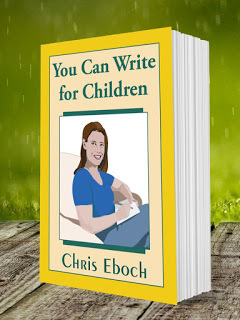 “A must for your writing library!”
“A must for your writing library!”Remember the magic of bedtime stories? When you write for children, you have the most appreciative audience in the world. But to reach that audience, you need to write fresh, dynamic stories, whether you’re writing rhymed picture books, middle grade mysteries, edgy teen novels, nonfiction, or something else.
In this book, you will learn:
How to explore the wide variety of age ranges, genres, and styles in writing stories, articles and books for young people.How to find ideas.How to develop an idea into a story, article, or book.The basics of character development, plot, setting, and theme – and some advanced elements.How to use point of view, dialogue, and thoughts.How to edit your work and get critiques.Where to learn more on various subjects.
Whether you’re just starting out or have some experience, this book will make you a better writer – and encourage you to have fun!
“A definite winner in the how-to-write book library.”
You Can Write for Children: How to Write Great Stories, Articles, and Books for Kids and Teenagers is available for the Kindle, in paperback, or in Large Print paperback.
Chris Eboch's novels for ages nine and up include The Eyes of Pharaoh, a mystery in ancient Egypt; The Well of Sacrifice, a Mayan adventure; The Genie’s Gift, a middle eastern fantasy; and the Haunted series, about kids who travel with a ghost hunter TV show, which starts with The Ghost on the Stairs.
See all of Chris’s links.September 13, 2021
Intro to Self-Publishing with Chris Eboch: Handout #amwriting
Intro to Self-Publishing with Chris Eboch (for SCBWI-Houston, 9/13/2021)
Who Should Self Publish:
• Traditionally published authors who want to make out-of-print titles available again.
• Published authors who wish to release books in a series that a publisher has dropped.
• Professional writers who have a book that doesn’t suit the current market, but may still find a modest audience.
• People who have a marketing platform for distributing their books, e.g. they do a lot of speaking on a professional topic and can sell books at their talks (best for nonfiction).
• Amateur writers who want to make a title available in print form for their family, such as memoirs or family genealogy, or a child’s favorite story.
• First-time authors who have studied writing for several years and gotten professional feedback on their manuscript, who also:
• want complete control of the publishing process
• prefer the work of self-publishing to the work of researching and querying publishers
• enjoy marketing and have experience with it
• and/or feel they don’t have time to wait on the traditional publishing industry
Advantages:
You retain all rights to your work. You can earn more per copy sold.
You get to make decisions about cover art, pricing, content -- basically everything.
If the book does extremely well, you may interest a traditional publisher.
You get to see your book in print in a few months, instead of several years if ever.
Disadvantages:
You get no advance. You may sell few copies and make hardly any money -- ever.
You have to make all the decisions about cover art, pricing, content -- basically everything.
A poorly written/edited/designed book can hurt your reputation as an author.
To produce a professional-quality book, you will have to spend hundreds or thousands of dollars and dozens or hundreds of hours of time. You have no marketing support from a publisher.
Your book will not be available in bookstores.
Steps to Self-Publishing:
• Write and edit a book. Edit it some more. Get professional critiques and edit again.
• Write any front/back matter: title page, illustrated by, summary, dedication, acknowledgments, “other books by,” authors note, bio, etc. (You can follow the format in other books).
• Hire a professional copy editor and approve/reject their suggestions.
• Hire an illustrator. Make sure you understand whether you are getting only cover art, or complete cover design with title and (for print on demand) spine and back of book. What rights are you buying?
• Upload, publish.
• Publicity and marketing.
Resources:
Download Chris’s Indie Publishing Worksheet: https://chriseboch.com/for-writers/
David Gaughran: books, videos, a newsletter, and a free courses on self-publishing: https://davidgaughran.com/
Jane Friedman: blog and newsletter with a focus on business: https://www.janefriedman.com/
Darcy Pattison: a blog focused on SP children’s books: https://www.darcypattison.com/category/publishing/
Roxie Munro: a blog focused on SP children’s books (not recently updated):
IBPA: Independent book publishers Association (news, discounts on services): https://www.ibpa-online.org/
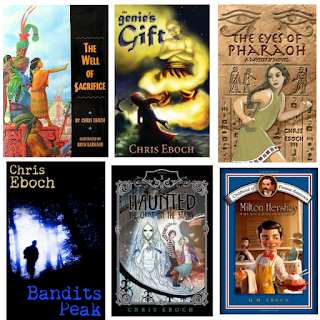 Chris Eboch is the author of over 100 books for children, including nonfiction and fiction, early reader through teen. Her novels for ages nine and up include The Eyes of Pharaoh, a mystery in ancient Egypt; The Well of Sacrifice, a Mayan adventure used in many schools; The Genie’s Gift, a middle eastern fantasy; and the Felony Melanie series featuring the characters from the movie Sweet Home Alabama as teenagers. Her writing craft books include You Can Write for Children: How to Write Great Stories, Articles, and Books for Kids and Teenagers, and Advanced Plotting.
Chris Eboch is the author of over 100 books for children, including nonfiction and fiction, early reader through teen. Her novels for ages nine and up include The Eyes of Pharaoh, a mystery in ancient Egypt; The Well of Sacrifice, a Mayan adventure used in many schools; The Genie’s Gift, a middle eastern fantasy; and the Felony Melanie series featuring the characters from the movie Sweet Home Alabama as teenagers. Her writing craft books include You Can Write for Children: How to Write Great Stories, Articles, and Books for Kids and Teenagers, and Advanced Plotting. Learn more at chriseboch.com or her Amazon page, or check out her writing tips at her Write Like a Pro! blog.
 Chris also writes mystery, romance, and suspense for adults under the name Kris Bock. Her Furrever Friends Sweet Romance series features the employees and customers at a cat café. Watch as they fall in love with each other and shelter cats. Get a free 10,000-word story set in the world of the Furrever Friends cat café when you sign up for the Kris Bock newsletter. Learn more at www.krisbock.com or visit Kris Bock’s Amazon US page or Amazon UK page. (For other countries click here.)
Chris also writes mystery, romance, and suspense for adults under the name Kris Bock. Her Furrever Friends Sweet Romance series features the employees and customers at a cat café. Watch as they fall in love with each other and shelter cats. Get a free 10,000-word story set in the world of the Furrever Friends cat café when you sign up for the Kris Bock newsletter. Learn more at www.krisbock.com or visit Kris Bock’s Amazon US page or Amazon UK page. (For other countries click here.)
August 7, 2021
Calling #KidLit Writers - Learn more about Educational Publishing in an 8-week webinar series with a Mentorship Option #amwriting #writing
 Educational Publishing Webinar Series with Mentorship Option
Educational Publishing Webinar Series with Mentorship Option Do you want to make money from writing? Are you willing and able to write on assignment if given a topic, word count, grade level, and deadline? Then you may be perfect for educational work for hire!
Educational publishers need writers for nonfiction and fiction books, test passages and questions, lesson plans, and more. Learn about the options in educational publishing, what makes a good work-for-hire writer, how to approach publishers, and how to produce a good resume and writing sample.
Attendees will have two options:
Watch the webinar series and work on your own. Be paired with a mentor who will review assignments. Those who complete the course assignments will finish with a writing sample and resume as well as connections to editors. The number of participants at this level will be limited by the number of mentors. $400 totalWHEN: The webinar series will be on 7 Saturdays, starting September 4 and going through October 16. These webinars will start at 1 PM PT; 2 PM MT; 3 PM CT; 4 PM ET . In addition, a roundtable with editors or individual meet and greet sessions with editors will be scheduled at the editors’ availability. See the website for the full schedule.
Key Points:
· Overview of Educational Publishing: What is it? Why would you do it? Books, test passages, curriculum development, and more. Pros and cons of work for hire. The qualities of a good work-for-hire writer.
· Getting work: Identifying publishers. Submitting your resume and writing samples.
· Understanding publisher guidelines for assignments. Time-efficient research. Choosing kid-friendly angles and facts to include. Writing in the appropriate style. Writing to an assigned grade level.
· Please note: This program cannot guarantee you will find work in educational publishing. Some students may be ready to seek work at the end, while others will leave the course with advice on how to further their skills through additional study and practice.
Limited scholarships are available. If you are in a community that is traditionally underrepresented, and also have financial need, please apply for a scholarship. See the website for more info.
June 9, 2021
Advanced Plotting Tools and Techniques: A #Writing class via Zoom, 4 weeks in July - #AmWriting better this summer!
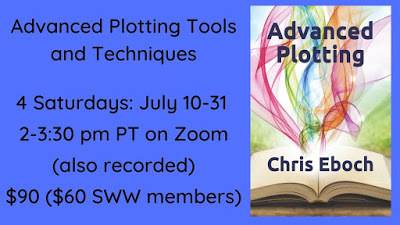 Advanced Plotting Tools and Techniques
Advanced Plotting Tools and Techniques
4-week Course: Saturdays: July 10, 17, 24, and 31
3-4:30 pm MT (2 PT/4 CT/5 ET) via Zoom
$60 SWW members; $90 Nonmembers
Many books and workshops teach the basics of plotting: conflict, complications, climax. Now learn advanced techniques that will make a decent plot dynamic. Start with a “grab you by the throat” opening to pull readers into the story. Learn how to pack the plot full by complicating your complications. Control your pacing through sentence and paragraph length. And finally, cliffhanger chapter endings ensure late-night reading under the covers. Learn techniques to make any story or book better. Novelists will benefit from these insights, whether they are just starting out or have years of experience.
Students in Chris's most recent class said:
Exceptional job!I couldn’t have asked for a better experience!Chris is an incredible instructor. I really like the depth she brings to her teachingI learned a lot from the course, too. I thought it was terrific!This writer’s series was hands down one of the best I have attended!
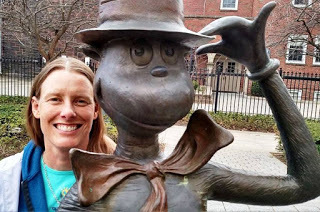 Chris Eboch is the author of over 60 books for young people, including mysteries, ghost stories, fantasy, and historical fiction. Learn more at ChrisEboch.com or her Amazon page.
Chris Eboch is the author of over 60 books for young people, including mysteries, ghost stories, fantasy, and historical fiction. Learn more at ChrisEboch.com or her Amazon page.As Kris Bock, Chris writes novels of romance, mystery, and suspense. Her Furrever Friends Sweet Romance series features the employees and customers at a cat café as they fall in love with each other and shelter cats. Her humorous mystery series about an injured war correspondent who moves home again launches in May. She also writes romantic suspense novels about treasure hunting, archaeology, and intrigue in the Southwest. Learn more at KrisBock.com or visit Kris Bock’s Amazon page.
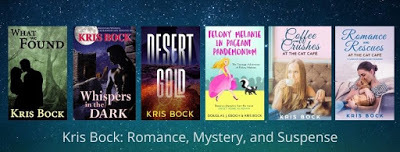 Register: by calling the SWW office (505-830-6034, Monday-Thursday, 9:00 am – noon), or by using the
online registration form
. (Our online payment portal utilizes PayPal, but you’ll be given an option to pay by credit card without signing into PayPal.)
Register: by calling the SWW office (505-830-6034, Monday-Thursday, 9:00 am – noon), or by using the
online registration form
. (Our online payment portal utilizes PayPal, but you’ll be given an option to pay by credit card without signing into PayPal.)Zoom Meeting: The Zoom invitation link and the password will be emailed to those who purchase this class. For more information, please contact the class/workshop coordinator at Info@SWWriters.com.
The classes will be recorded for those who have to miss one.
May 13, 2021
You Can Write for Children: #99c sale - #amwriting #KidLit #writing
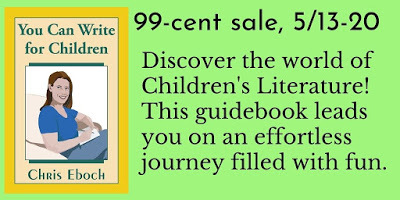 On sale May 13-20:
On sale May 13-20:You Can Write for Children : How to Write Great Stories, Articles, and Books for Kids and Teenagers
Just 99 cents for the Kindle. Also available in paperback or in Large Print paperback.
Remember the magic of bedtime stories? When you write for children, you have the most appreciative audience in the world. But to reach that audience, you need to write fresh, dynamic stories, whether you’re writing rhymed picture books, middle grade mysteries, edgy teen novels, nonfiction, or something else.
In this book, you will learn:
How to explore the wide variety of age ranges, genres, and styles in writing stories, articles and books for young people.
How to find ideas.How to develop an idea into a story, article, or book.The basics of character development, plot, setting, and theme – and some advanced elements.How to use point of view, dialogue, and thoughts.How to edit your work and get critiques.Where to learn more on various subjects.Whether you’re just starting out or have some experience, this book will make you a better writer – and encourage you to have fun!
"A must for your writing library!"
"If you want to write for children or the children’s market, this is the book for you."
"If you have thought of writing a book for children, this book will take you from the “idea” stage all the way through to the “finished” stage."
"This is a terrific resource book for anyone who has considered writing for children. Each chapter has a tip section as well as specific resources, concrete examples, and easy to understand explanation of terms and topics. Excellent book!"
"If you've ever dreamed of writing for children, Chris Eboch's book is a great resource. An accomplished writer, Chris knows just what it takes to turn this dream into reality and shares her knowledge in multiple chapters that discuss getting ideas, building conflict, story structure, setting, dialogue, themes, and much more. A definite winner in the how-to-write book library."
 Chris Eboch is the author of over 60 books for children, including nonfiction and fiction, early reader through teen. Her novels for ages nine and up include The Eyes of Pharaoh, a mystery in ancient Egypt; The Well of Sacrifice, a Mayan adventure used in many schools; The Genie’s Gift, a middle eastern fantasy; and the Haunted series, about kids who travel with a ghost hunter TV show, which starts with The Ghost on the Stairs. Her other writing craft book is Advanced Plotting.
Chris Eboch is the author of over 60 books for children, including nonfiction and fiction, early reader through teen. Her novels for ages nine and up include The Eyes of Pharaoh, a mystery in ancient Egypt; The Well of Sacrifice, a Mayan adventure used in many schools; The Genie’s Gift, a middle eastern fantasy; and the Haunted series, about kids who travel with a ghost hunter TV show, which starts with The Ghost on the Stairs. Her other writing craft book is Advanced Plotting. Learn more at chriseboch.com or her Amazon page,
May 3, 2021
Plot Like a Screenwriter 2 with Douglas J. Eboch #scriptchat #scriptwriting #amwriting
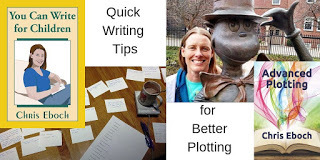 Last week I posted a partial excerpt of an essay by my brother, scriptwriter Douglas J. Eboch. Here's a little more about plotting like a screenwriter, from his essay in my writing book, Advanced Plotting. Last Friday I posted the section about the Dramatic Question.
Last week I posted a partial excerpt of an essay by my brother, scriptwriter Douglas J. Eboch. Here's a little more about plotting like a screenwriter, from his essay in my writing book, Advanced Plotting. Last Friday I posted the section about the Dramatic Question.Apparent Failure/Success
There’s one other critical structural concept you need to understand. That is the moment of apparent failure (or success). Whatever the Resolution to your Dramatic Question is, there needs to be a moment where the opposite appears to be inevitable. If your character succeeds at the end, you need a moment where it appears the character must fail. And if your character fails at the end, you need a moment where they appear about to succeed.
This moment should come late in the story as the tension is building toward the climax. We need it so the audience can’t predict how the movie’s going to unfold. We may know that in a big Hollywood movie the hero will beat the bad guy and get the girl, but we shouldn’t be able to figure out how they’ll accomplish that. In screenwriting, we call this moment of apparent failure/success the Act Two Break.
[For a full explanation of the three act structure, pick up Advanced Plotting or explore Doug's screenwriting blog, Let's Schmooze.]
The Act Two Break
The Act Two Break is one of the most critical beats of your story. It’s often referred to as the “lowest moment,” though I don’t like that because I think it’s misleading. Seldom do I see a successful story where things start getting better right after the Act Two Break. I think “moment of greatest failure” is a better description. It’s also sometimes called the “all is lost” moment, which is pretty good. The point is that this is when it looks like your character is doomed to fail. The Act Two Break in E.T. is E.T. apparently dying and the breaking of the psychic link with Elliot.
That assumes, of course, that ultimately your character will succeed. Some stories, like Little Miss Sunshine, end with the character failing in their goal, and in this case you have to reverse the Act Two Break. It becomes the moment of greatest success. Gangster movies often work this way—the gangster seizes control of the gang at the end of Act Two and looks like he’ll be unstoppable. But by the end he’ll be lying dead in the street, riddled with bullets.
Why is this so important? Because the ending won’t be satisfying unless it’s hard to achieve. And you don’t want your movie to feel completely predictable. This is the point where the audience needs to think, “Boy, I know the hero must be going to beat the bad guy and get the girl (this is a movie, after all), but I sure don’t know how he’s going to do it. It seems hopeless.”
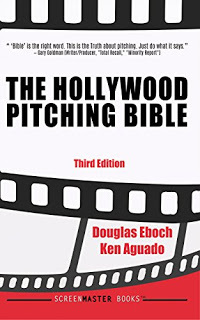 http://screenmasterbooks.com/hpb.html
http://screenmasterbooks.com/hpb.htmlHope and fear come into play here. What is the audience rooting for? Do they want the character to succeed or fail? (Both are possibilities depending on your premise.) This is the moment where you make them think the opposite might actually happen. Or in a tragedy you make them think they might get the ending they want, only to snatch it away from them. Romeo and Juliet hatch a plan to run away together… maybe it will all work out after all….
The Act Two Break in Star Wars is when our heroes escape the Death Star in the Millennium Falcon… but we learn that Darth Vadar has put a tracking device on their ship. It’s their biggest failure because they’re going to lead the bad guys right to the rebel base.
The Resolution
The Resolution is the climax of the movie. It should be big and exciting and emotional. It is also the moment when the Dramatic Question is answered either positively or negatively. Thus, it is what we’ve been waiting for since the Catalyst.
In addition to making this a big moment, it is crucial that you make it a final moment. The Dramatic Question must be answered definitively. If our hero can just go out and try again, then we don’t feel like the question is resolved. The Resolution must be the last chance for success or failure. If Luke can’t destroy the Death Star, then the rebellion will be crushed. It’s not just another battle; it’s the climactic battle.
The resolution is usually pretty obvious. Luke destroys the Death Star. E.T. gets to the spaceship. In Little Miss Sunshine, Richard gets up onstage with Olive and dances with her in support, and in defiance of the pageant people who want Olive off the stage. Olive may lose the pageant, answering the Dramatic Question in the negative, but the previously dysfunctional family has come together.
These are [some of] the structural stages Hollywood screenwriters use to build well-plotted scripts. Of course, a well-structured script isn’t the same as a good script. You still have to write the actual characters and scenes. But if you have a strong plot, then you have a solid foundation that will allow you to tell a truly great story.
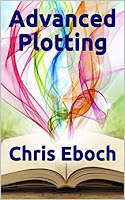 Douglas J. Eboch wrote the original script for the movie Sweet Home Alabama. He teaches at Art Center College of Design and lectures internationally. He writes a blog about screenwriting at Let's Schmooze where he shares techniques like the ones in this article.
Douglas J. Eboch wrote the original script for the movie Sweet Home Alabama. He teaches at Art Center College of Design and lectures internationally. He writes a blog about screenwriting at Let's Schmooze where he shares techniques like the ones in this article.See Doug’s entire 4000-word essay covering all the dramatic story points of three-act structure, plus much more, in Advanced Plotting. Buy Advanced Plotting
 for $9.99 in paperback or as a $4.99 e-book, free in Kindle Unlimited.
for $9.99 in paperback or as a $4.99 e-book, free in Kindle Unlimited.April 26, 2021
Plot Like a Screenwriter with Douglas J. Eboch #scriptchat #scriptwriting #amwriting
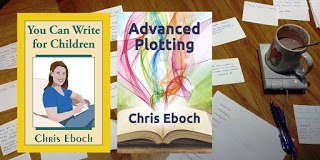 If you've been following this blog for long, you've probably “met” my brother, scriptwriter Douglas J. Eboch. I love talking about writing with him and following his screenwriting blog, Let's Schmooze. Novelists can learn a lot from movie writers. Here's an excerpt from the essay Doug wrote for my book
Advanced Plotting
. This works with our exploration of building your novel.
If you've been following this blog for long, you've probably “met” my brother, scriptwriter Douglas J. Eboch. I love talking about writing with him and following his screenwriting blog, Let's Schmooze. Novelists can learn a lot from movie writers. Here's an excerpt from the essay Doug wrote for my book
Advanced Plotting
. This works with our exploration of building your novel.Plotting Like a Screenwriterby Douglas J. Eboch
Now let’s look at the components of three act structure. Probably the most important is the Dramatic Question. If you understand nothing else but the Dramatic Question and the Moment of Failure (which I’ll get to in a bit) you’ll probably end up with a fairly well structured story.
What the Dramatic Question Is
The Dramatic Question is the structural spine of your story. On some level all Dramatic Questions can be boiled down to “Will the character solve their dilemma?” Of course that’s not very helpful to the writer trying to crack a particular story. You need to ask that question with the specifics of your character and dilemma.
So in Star Wars (written by George Lucas) the question is “Will Luke Skywalker defeat Darth Vadar?” In E.T. The Extra-Terrestrial (written by Melissa Mathison) it’s “Can Elliot save E.T.?” In Little Miss Sunshine (written by Michael Arndt) it’s “Will Olive win the beauty pageant?”
Those sound simple, right? Simpler is better when it comes to the Dramatic Question. But it’s not always easy to be simple. You have to know who your character is and what their dilemma is before you can craft a nice simple Dramatic Question. But then if you haven’t figured out your character and their dilemma, you’re not really ready to start writing yet anyway!
I also think it’s good to phrase the Dramatic Question as a yes or no question. So it’s not “Who will Susan marry?” it’s “Will Susan marry Bill?” Keeping it yes/no helps you tightly focus your narrative.
What the Dramatic Question Is Not
The Dramatic Question is not the theme of your movie. It’s not the hook. It’s not necessarily the character arc (sometimes it is, but not usually.) It doesn’t define whether your story is sophisticated or facile.
Do not think the Dramatic Question determines the quality of your story. It’s simply the spine on which you’re going to build your story. What you hang on that spine is going to determine how good your script is. Just because a person doesn’t collapse under the weight of their own body doesn’t mean they’re beautiful, intelligent, interesting, or emotionally complex. However, if your spine isn’t solid, none of the other stuff is going to work properly either.
How to use the Dramatic Question in your story
The Dramatic Question is an unspoken agreement with the audience. It tells them what the scope and shape of the story is going to be. They need to know what the question is fairly early in the proceedings or you will lose them. If too much time passes before they understand the Dramatic Question they’re liable to walk out of the theater or turn the DVD off or put down your script. They’ll say something like, “I couldn’t figure out what the movie was about.”
The moment when the Dramatic Question becomes clear is called the Catalyst. The Catalyst is where the audience understands who the main character is and what their basic dilemma is. They may not understand the entire dimension of the problem, but they have an idea what the story arc will be about.
So in E.T. the catalyst is when Elliot sees E.T. for the first time. We don’t yet know that his mission will ultimately be to get E.T. home or even that first he’ll have to hide E.T. And we don’t know that E.T. will start dying from the Earth environment. But we know that this kid who nobody takes seriously just found a little lost alien—and that some scary men are looking for it. We have a character with a dilemma.
Similarly, when the audience knows the outcome of the Dramatic Question, your story is over. The audience will stick with you for a few minutes of wrap up, but if you go on too long after resolving the dramatic question, they’re going to get restless. They’ll say things like, “it was anti-climactic” or “it had too many endings.”
Once E.T. takes off in his space ship, the movie ends. Credits roll. The story is over. Compare that to the Lord of the Rings trilogy (screenplay by Fran Walsh & Philippa Boyens & Peter Jackson). The Dramatic Question is “Can Frodo destroy the ring?” He does, but then the movie continues for another forty minutes or so. Kind of got tedious didn’t it? The story was over. We wanted to go home.
The structural beat where you answer the Dramatic Question is called the Resolution.
Douglas J. Eboch wrote the original script for the movie Sweet Home Alabama. He teaches at Art Center College of Design and lectures internationally. He writes a blog about screenwriting at Let's Schmooze where he shares techniques like the ones in this article.
 See Doug’s entire 4000-word essay covering all the dramatic story points of three-act structure, plus much more, in Advanced Plotting. Get more essay like this one in Advanced Plotting, along with a detailed explanation of the Plot Outline Exercise, a powerful tool to identify and fix plot weaknesses in your manuscripts.
See Doug’s entire 4000-word essay covering all the dramatic story points of three-act structure, plus much more, in Advanced Plotting. Get more essay like this one in Advanced Plotting, along with a detailed explanation of the Plot Outline Exercise, a powerful tool to identify and fix plot weaknesses in your manuscripts. Buy Advanced Plotting
 for $9.99 in paperback or as a $4.99 e-book on Amazon - free in Kindle Unlimited.
for $9.99 in paperback or as a $4.99 e-book on Amazon - free in Kindle Unlimited.
April 11, 2021
Critique Group Characters: #amwriting tips for better feedback on your #writing
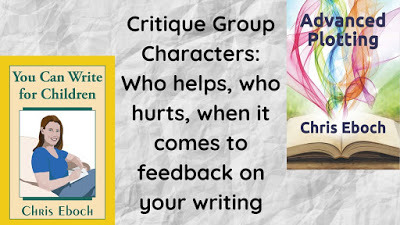 This excerpt from How to Write Great Stories, Articles, and Books for Kids and Teenagers is from the chapter on Critiques. See the list of topics to the right to find more on critiques.
This excerpt from How to Write Great Stories, Articles, and Books for Kids and Teenagers is from the chapter on Critiques. See the list of topics to the right to find more on critiques.Here are some specific character types to watch out for in your critique group.
Critique Group Characters
Watch out for the following personality types in a critique group:
 It's all wonderful!
It's all wonderful!Art by Lois BradleyThe Cheerleader. She loves everything you do! This is gratifying, especially when you are doubting your talent, but it’s not particularly helpful in improving your work.
The Grammarian. He doesn’t have a lot to say about the content of your work, but he’ll circle every typo in red pen and may insist you follow strict grammar rules that have gone out of date. (By the way, I never use red pen on critiques – blue, purple, or green ink stands out from the black text, without that negative association of graded English papers.)
 Me? An opinion?The Mouse. You can’t tell whether or not she likes your work, because she never voices an opinion. She might hide behind the excuse that she’s not experienced enough to offer feedback. She’ll do this for years.
Me? An opinion?The Mouse. You can’t tell whether or not she likes your work, because she never voices an opinion. She might hide behind the excuse that she’s not experienced enough to offer feedback. She’ll do this for years.The Perpetual Beginner. He truly isn’t experienced enough to offer feedback, and he never seems to improve. This type can be divided into The Rut, who brings in the same manuscript over and over without ever making substantial changes (despite all your thoughtful advice) and The Hummingbird, who throws away a manuscript as soon as it’s gotten one negative comment, preferring to work on something new.
The Chatterbox. She wants to talk about anything and everything – other than the manuscripts you’re supposed to be critiquing. This person sees a writing group as a social occasion, not a way to improve your craft.
 That's not how I'd do it.Father Knows Best. He always has an opinion, which he voices clearly and often. He prefers to discuss how he would write the story if it were his own, ignoring the author’s vision.
That's not how I'd do it.Father Knows Best. He always has an opinion, which he voices clearly and often. He prefers to discuss how he would write the story if it were his own, ignoring the author’s vision. The Bully. She enjoys tearing apart your manuscript. No suggestions, just criticisms bordering on insults.
All these characters have one thing in common. They don’t help you improve your work. Having one Cheerleader in the group can be nice, as it means you’ll hear some praise. The Grammarian may be useful, although often those comments are unnecessary and time-consuming when you are still developing a story and focusing on the big picture, not proofreading.
The Mouse and the Perpetual Beginner don’t do a lot of harm, but they waste your time. Why should you spend hours doing thoughtful critiques when you’re not getting anything in return? (Note, sometimes these people can learn over time. Ask for the type of feedback you want, such as "Please point out where you got bored or confused," or encourage them to use a critique form that asks specific questions. But if they won’t make an effort to be better critique partners, it may be time to end the relationship.)
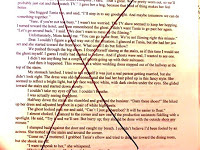 Some people hate everythingThe Chatterbox is an even bigger time waster. Sometimes that person can be controlled by having a set time for visiting, perhaps the first or last half hour of each meeting. Including some social time is a way for the group to bond. Some critique groups like to start or end with a nice potluck meal. You could also have one or two meetings a year that are purely social. If there’s a way to get Father Knows Best or the Bully to change their behavior, I don’t know it. They should be avoided.
Some people hate everythingThe Chatterbox is an even bigger time waster. Sometimes that person can be controlled by having a set time for visiting, perhaps the first or last half hour of each meeting. Including some social time is a way for the group to bond. Some critique groups like to start or end with a nice potluck meal. You could also have one or two meetings a year that are purely social. If there’s a way to get Father Knows Best or the Bully to change their behavior, I don’t know it. They should be avoided.A good critique is kind and supportive, pointing out both good qualities and weak spots in your manuscript, and giving you ideas for how to improve it. The best critiques leave you fired up and ready to get to work on revisions, even if you know you have a lot of work ahead. Look for people who can provide that.
If you've run into these characters, do you have advice on dealing with them? Are there other character types to watch out for?
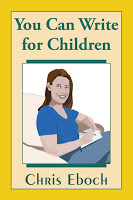 You can get this whole essay, and a lot more – including a chapter on Advanced Critique Questions – inYou Can Write for Children: A Guide to Writing Great Stories, Articles, and Books for Kids and Teenagers. Order for Kindle, in paperback, or in Large Print paperback.
You can get this whole essay, and a lot more – including a chapter on Advanced Critique Questions – inYou Can Write for Children: A Guide to Writing Great Stories, Articles, and Books for Kids and Teenagers. Order for Kindle, in paperback, or in Large Print paperback.Cat emoticons by Lois Bradley.
Chris Eboch is the author of over 60 books for children, including nonfiction and fiction, early reader through teen. Her novels for ages nine and up include The Eyes of Pharaoh, a mystery in ancient Egypt; The Well of Sacrifice, a Mayan adventure used in many schools; The Genie’s Gift, a middle eastern fantasy; and the Haunted series, about kids who travel with a ghost hunter TV show, which starts with The Ghost on the Stairs. Learn more at chriseboch.com or her Amazon page.
March 15, 2021
Editing Your Novel during #NaNoEdMo ��� Editing Tips - #Writing #KidLit
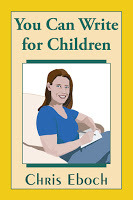 In honor of #NaNoEdMo (National Novel Editing Month), I'm sharing some advice from You Can Write for Children: A Guide to Writing Great Stories, Articles, and Books for Kids and Teenagers. Two weeks ago I offered advice on ���big picture��� editing. Last week I covered Fine Tuning. Here are some final quick tips on editing to help you through NaNoEdMo.
In honor of #NaNoEdMo (National Novel Editing Month), I'm sharing some advice from You Can Write for Children: A Guide to Writing Great Stories, Articles, and Books for Kids and Teenagers. Two weeks ago I offered advice on ���big picture��� editing. Last week I covered Fine Tuning. Here are some final quick tips on editing to help you through NaNoEdMo.Editing Tips:
Don���t try to edit everything at once. Make several passes, looking for different problems. Start big, then focus in on details.
Try writing a one- or two-sentence synopsis. Define your goal. Do you want to produce an action-packed thriller? A laugh-out-loud book that will appeal to preteen boys? A richly detailed historical novel about a character���s internal journey? Identifying your goal can help you make decisions about what to cut and what to keep.
Next make a scene list, describing what each scene does.Do you need to make major changes to the plot, characters, setting, or theme (fiction) or the focus of the topic (nonfiction)?Does each scene fulfill the synopsis goal? How does it advance plot, reveal character, or both?Does each scene build and lead to the next? Are any redundant? If you cut the scene, would you lose anything? Can any secondary characters be combined or eliminated?Does anything need to be added or moved? Do you have a length limit or target?Can you increase the complications, so that at each step, more is at stake, there���s greater risk or a better reward? If each scene has the same level of risk and consequence, the pacing is flat and the middle sags.Check for accuracy. Are your facts correct? Are your characters and setting consistent?Does each scene (in fiction) or paragraph (in nonfiction) follow a logical order and stick to the topic?Is your point of view consistent?Do you have dynamic language: Strong, active verbs? A variety of sentence lengths (but mostly short and to the point)? No clich��s? Do you use multiple senses (sight, sound, taste, smell, touch)?Finally, edit for spelling and punctuation.
(For detailed editing questions, see my Plot Outline Exercise. It���s in my book Advanced Plotting or available as a free Word download on my website.)
Editing Description
For each detail, ask:Does it make the story more believable?Does it help readers picture or understand a character or place better?Does it answer questions that readers might want answered?Does it distract from the action?Could it be removed without confusing readers or weakening the story?For illustrated work, could the description be replaced by illustrations?
Use more details for unusual/unfamiliar settings. Try using multiple senses: sights, sounds, smells, tastes, and the feeling of touch. Especially in picture books, use senses other than sight, which can be shown through the illustrations.
Editing Resources:

Print/Ebook Advanced Plotting , by Chris EbochSelf-Editing for Fiction Writers, by Renni Browne and Dave KingStyle That Sizzles & Pacing for Power ��� An Editor���s Guide to Writing Compelling Fiction, by Jodie RennerManuscript Makeover, by Elizabeth LyonNovel Metamorphosis, by Darcy PattisonRevision & Self-Editing, by James Scott BellThanks, But This Isn���t For Us, by Jessica Page Morrell
Online I haven���t tried this, but the ���Hemingway App��� is designed to identify overly long or complicated sentences, so it might be helpful in learning to simplify your work for younger audiences.
Grammarly is a free app that claims to find more errors than Microsoft Word���s spelling and grammar check option, including words that are spelled correctly but used incorrectly.
Resources for Writers, by editor Jodie Renner, list several of her editing books as well as blog posts on various writing topics.
The Plot Outline Exercise from Advanced Plotting helps you analyze your plot for trouble spots.
Middle grade author Janice Hardy���s Fiction University blog has great posts on many writing craft topics.
Author and writing teacher Jordan McCollum offers downloadable free writing guides on topics such as character arcs and deep point of view.
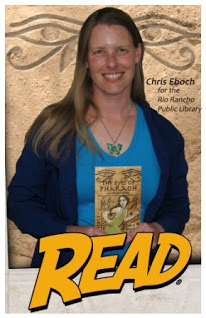 Subscribe to get posts automatically and never miss a post. You can use the Subscribe buttons to the right, or add http://chriseboch.blogspot.com/ to Feedly or another reader.
Subscribe to get posts automatically and never miss a post. You can use the Subscribe buttons to the right, or add http://chriseboch.blogspot.com/ to Feedly or another reader.You can get the extended version of this essay, and a lot more, in You Can Write for Children: A Guide to Writing Great Stories, Articles, and Books for Kids and Teenagers., available for the Kindle, in paperback, or in Large Print paperback. Advanced Plotting also has advice on editing novels.
Chris Eboch is the author of over 60 books for children, including nonfiction and fiction, early reader through teen. Her novels for ages nine and up include The Eyes of Pharaoh, a mystery in ancient Egypt; The Well of Sacrifice, a Mayan adventure used in many schools; The Genie���s Gift, a middle eastern fantasy; and the Haunted series, about kids who travel with a ghost hunter TV show, which starts with The Ghost on the Stairs.
Learn more or read excerpts at www.chriseboch.com or visit her page on Amazon or Amazon UK. (For other countries click here.)Chris also writes novels of suspense and romance for adults under the name Kris Bock; read excerpts at www.krisbock.com.Editing Your Novel during #NaNoEdMo – Editing Tips - #Writing #KidLit
 In honor of #NaNoEdMo (National Novel Editing Month), I'm sharing some advice from You Can Write for Children: A Guide to Writing Great Stories, Articles, and Books for Kids and Teenagers. Two weeks ago I offered advice on “big picture” editing. Last week I covered Fine Tuning. Here are some final quick tips on editing to help you through NaNoEdMo.
In honor of #NaNoEdMo (National Novel Editing Month), I'm sharing some advice from You Can Write for Children: A Guide to Writing Great Stories, Articles, and Books for Kids and Teenagers. Two weeks ago I offered advice on “big picture” editing. Last week I covered Fine Tuning. Here are some final quick tips on editing to help you through NaNoEdMo.Editing Tips:
Don’t try to edit everything at once. Make several passes, looking for different problems. Start big, then focus in on details.
Try writing a one- or two-sentence synopsis. Define your goal. Do you want to produce an action-packed thriller? A laugh-out-loud book that will appeal to preteen boys? A richly detailed historical novel about a character’s internal journey? Identifying your goal can help you make decisions about what to cut and what to keep.
Next make a scene list, describing what each scene does.Do you need to make major changes to the plot, characters, setting, or theme (fiction) or the focus of the topic (nonfiction)?Does each scene fulfill the synopsis goal? How does it advance plot, reveal character, or both?Does each scene build and lead to the next? Are any redundant? If you cut the scene, would you lose anything? Can any secondary characters be combined or eliminated?Does anything need to be added or moved? Do you have a length limit or target?Can you increase the complications, so that at each step, more is at stake, there’s greater risk or a better reward? If each scene has the same level of risk and consequence, the pacing is flat and the middle sags.Check for accuracy. Are your facts correct? Are your characters and setting consistent?Does each scene (in fiction) or paragraph (in nonfiction) follow a logical order and stick to the topic?Is your point of view consistent?Do you have dynamic language: Strong, active verbs? A variety of sentence lengths (but mostly short and to the point)? No clichés? Do you use multiple senses (sight, sound, taste, smell, touch)?Finally, edit for spelling and punctuation.
(For detailed editing questions, see my Plot Outline Exercise. It’s in my book Advanced Plotting or available as a free Word download on my website.)
Editing Description
For each detail, ask:Does it make the story more believable?Does it help readers picture or understand a character or place better?Does it answer questions that readers might want answered?Does it distract from the action?Could it be removed without confusing readers or weakening the story?For illustrated work, could the description be replaced by illustrations?
Use more details for unusual/unfamiliar settings. Try using multiple senses: sights, sounds, smells, tastes, and the feeling of touch. Especially in picture books, use senses other than sight, which can be shown through the illustrations.
Editing Resources:

Print/Ebook Advanced Plotting , by Chris EbochSelf-Editing for Fiction Writers, by Renni Browne and Dave KingStyle That Sizzles & Pacing for Power – An Editor’s Guide to Writing Compelling Fiction, by Jodie RennerManuscript Makeover, by Elizabeth LyonNovel Metamorphosis, by Darcy PattisonRevision & Self-Editing, by James Scott BellThanks, But This Isn’t For Us, by Jessica Page Morrell
Online I haven’t tried this, but the “Hemingway App” is designed to identify overly long or complicated sentences, so it might be helpful in learning to simplify your work for younger audiences.
Grammarly is a free app that claims to find more errors than Microsoft Word’s spelling and grammar check option, including words that are spelled correctly but used incorrectly.
Resources for Writers, by editor Jodie Renner, list several of her editing books as well as blog posts on various writing topics.
The Plot Outline Exercise from Advanced Plotting helps you analyze your plot for trouble spots.
Middle grade author Janice Hardy’s Fiction University blog has great posts on many writing craft topics.
Author and writing teacher Jordan McCollum offers downloadable free writing guides on topics such as character arcs and deep point of view.
 Subscribe to get posts automatically and never miss a post. You can use the Subscribe buttons to the right, or add http://chriseboch.blogspot.com/ to Feedly or another reader.
Subscribe to get posts automatically and never miss a post. You can use the Subscribe buttons to the right, or add http://chriseboch.blogspot.com/ to Feedly or another reader.You can get the extended version of this essay, and a lot more, in You Can Write for Children: A Guide to Writing Great Stories, Articles, and Books for Kids and Teenagers., available for the Kindle, in paperback, or in Large Print paperback. Advanced Plotting also has advice on editing novels.
Chris Eboch is the author of over 60 books for children, including nonfiction and fiction, early reader through teen. Her novels for ages nine and up include The Eyes of Pharaoh, a mystery in ancient Egypt; The Well of Sacrifice, a Mayan adventure used in many schools; The Genie’s Gift, a middle eastern fantasy; and the Haunted series, about kids who travel with a ghost hunter TV show, which starts with The Ghost on the Stairs.
Learn more or read excerpts at www.chriseboch.com or visit her page on Amazon or Amazon UK. (For other countries click here.)Chris also writes novels of suspense and romance for adults under the name Kris Bock; read excerpts at www.krisbock.com.


